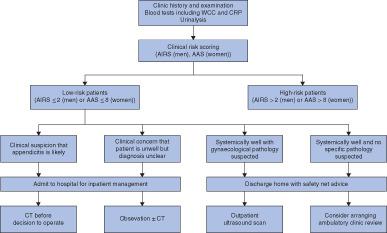当前位置:
X-MOL 学术
›
Br. J. Surg.
›
论文详情
Our official English website, www.x-mol.net, welcomes your
feedback! (Note: you will need to create a separate account there.)
Evaluation of appendicitis risk prediction models in adults with suspected appendicitis.
British Journal of Surgery ( IF 8.6 ) Pub Date : 2019-12-03 , DOI: 10.1002/bjs.11440 A. Bhangu ,
British Journal of Surgery ( IF 8.6 ) Pub Date : 2019-12-03 , DOI: 10.1002/bjs.11440 A. Bhangu ,

|
BACKGROUND
Appendicitis is the most common general surgical emergency worldwide, but its diagnosis remains challenging. The aim of this study was to determine whether existing risk prediction models can reliably identify patients presenting to hospital in the UK with acute right iliac fossa (RIF) pain who are at low risk of appendicitis.
METHODS
A systematic search was completed to identify all existing appendicitis risk prediction models. Models were validated using UK data from an international prospective cohort study that captured consecutive patients aged 16-45 years presenting to hospital with acute RIF in March to June 2017. The main outcome was best achievable model specificity (proportion of patients who did not have appendicitis correctly classified as low risk) whilst maintaining a failure rate below 5 per cent (proportion of patients identified as low risk who actually had appendicitis).
RESULTS
Some 5345 patients across 154 UK hospitals were identified, of which two-thirds (3613 of 5345, 67·6 per cent) were women. Women were more than twice as likely to undergo surgery with removal of a histologically normal appendix (272 of 964, 28·2 per cent) than men (120 of 993, 12·1 per cent) (relative risk 2·33, 95 per cent c.i. 1·92 to 2·84; P < 0·001). Of 15 validated risk prediction models, the Adult Appendicitis Score performed best (cut-off score 8 or less, specificity 63·1 per cent, failure rate 3·7 per cent). The Appendicitis Inflammatory Response Score performed best for men (cut-off score 2 or less, specificity 24·7 per cent, failure rate 2·4 per cent).
CONCLUSION
Women in the UK had a disproportionate risk of admission without surgical intervention and had high rates of normal appendicectomy. Risk prediction models to support shared decision-making by identifying adults in the UK at low risk of appendicitis were identified.
ANTECEDENTES
La apendicitis es la urgencia quirúrgica de cirugía general más frecuente en todo el mundo, pero su diagnóstico sigue siendo un desafío. El objetivo de este estudio fue determinar si los modelos de predicción de riesgo existentes pueden identificar de manera fiable a los pacientes del Reino Unido que se presentan en el hospital con dolor agudo en la fosa ilíaca derecha (right iliac fossa, RIF) con bajo riesgo de apendicitis. MÉTODOS: Se realizó una búsqueda sistemática para identificar todos los modelos existentes de predicción de riesgo de apendicitis. Los modelos se validaron utilizando los datos del Reino Unido de un estudio International prospectivo de cohortes que incluía pacientes consecutivos de 16 a 45 años que se presentaron en el hospital con dolor agudo en RIF entre marzo y junio de 2017. El criterio de valoración principal fue la mejor especificidad que era posible alcanzar con el modelo (proporción de pacientes que no tenían apendicitis correctamente clasificados como de bajo riesgo) manteniendo una tasa de fracaso < 5% (proporción de pacientes identificados como de bajo riesgo que realmente tuvieron apendicitis).
RESULTADOS
Se identificaron 5.345 pacientes en 154 hospitales del Reino Unido, de los cuales dos tercios (67,6%, 3.613/5.345) eran mujeres. Las mujeres tenían más del doble de probabilidades de someterse a una apendicectomía con un apéndice histológicamente normal (28,2%; 272/964) en comparación con los varones (12,1%; 120/993, riesgo relativo 2,33 (i.c. del 95% 1,92-2,84), P < 0,001)). Entre los 15 modelos de predicción de riesgo validados, el sistema de puntuación de apendicitis en adultos (Adult Appendicitis Score) fue el que obtuvo la mejor predicción (punto de corte ≤ 8, especificidad 63%, tasa de fracaso 3,7%). El sistema de puntuación de la respuesta inflamatoria de apendicitis (Appendicitis Inflammatory Response Score) fue el que obtuvo la mejor predicción en los varones (punto de corte ≤ 2, especificidad 25%, tasa de fracaso 2,4%). CONCLUSIÓN: Las mujeres del Reino Unido tuvieron un riesgo desproporcionado de ingreso sin intervención quirúrgica, así como porcentajes elevados de apendicectomías blancas. Se encontraron modelos de predicción de riesgos para apoyar la toma de decisiones compartida mediante la identificación de adultos del Reino Unido con bajo riesgo de apendicitis.
中文翻译:

疑似阑尾炎成人阑尾炎风险预测模型的评估。
背景阑尾炎是全世界最常见的普通外科急症,但其诊断仍然具有挑战性。本研究的目的是确定现有的风险预测模型是否能够可靠地识别因急性右髂窝 (RIF) 疼痛而到英国医院就诊且阑尾炎风险较低的患者。方法 完成系统搜索以确定所有现有的阑尾炎风险预测模型。使用来自一项国际前瞻性队列研究的英国数据对模型进行了验证,该研究捕获了 2017 年 3 月至 6 月期间因急性 RIF 入院就诊的连续 16-45 岁患者。主要结果是可实现的最佳模型特异性(未患阑尾炎的患者比例)正确分类为低风险),同时将失败率保持在 5% 以下(被确定为低风险但实际患有阑尾炎的患者比例)。结果 确定了英国 154 家医院的约 5345 名患者,其中三分之二(5345 名患者中的 3613 名,占 67·6%)是女性。女性接受切除组织学正常阑尾手术的可能性是男性(964 人中的 272 人,占 28·2%)的两倍多(993 人中的 120 人,占 12·1%)(相对风险为 2·33,占 95%)分 CI 1·92 至 2·84;在 15 个经过验证的风险预测模型中,成人阑尾炎评分表现最好(截止分数 8 或更低,特异性 63·1%,失败率 3·7%)。阑尾炎炎症反应评分在男性中表现最佳(截止评分为 2 或更低,特异性为 24·7%,失败率为 2·4%)。结论 英国女性在没有手术干预的情况下入院的风险不成比例,并且阑尾切除术正常的比率很高。 确定了风险预测模型,通过识别英国阑尾炎低风险成年人来支持共同决策。背景阑尾炎是全世界最常见的普外科急症,但其诊断仍然是一个挑战。本研究的目的是确定现有的风险预测模型是否能够可靠地识别因急性右髂窝 (RIF) 疼痛而入院的低阑尾炎患者。方法:进行系统搜索以确定所有现有的阑尾炎风险预测模型。该模型使用来自一项国际前瞻性队列研究的英国数据进行了验证,该研究包括 2017 年 3 月至 6 月期间因急性 RIF 疼痛入院的连续 16 至 45 岁患者。主要终点是该模型可能实现的最佳特异性(未正确分类为低风险的阑尾炎患者比例),同时保持失败率 < 5%(实际患有阑尾炎的被确定为低风险的患者比例)。结果:英国 154 家医院共识别出 5,345 名患者,其中三分之二(67.6%,3,613/5,345)是女性。与男性相比,组织学正常的阑尾接受阑尾切除术的女性 (28.2%; 272/964) 是男性的两倍多 (12.1%; 120/993,相对风险 2.33 (CI 95% 1.92-2.84),P < 0.001 ))。 在15个经过验证的风险预测模型中,成人阑尾炎评分系统的预测效果最好(临界值≤8,特异性63%,失败率3.7%)。阑尾炎炎症反应评分系统(阑尾炎炎症反应评分)是在男性中获得最佳预测的一种系统(截止点≤2,特异性25%,失败率2.4%)。结论:英国女性在没有手术干预的情况下入院的风险过高,并且白色阑尾切除术的发生率很高。研究发现,风险预测模型可以通过识别阑尾炎低风险的英国成年人来支持共同决策。
更新日期:2019-12-04
中文翻译:

疑似阑尾炎成人阑尾炎风险预测模型的评估。
背景阑尾炎是全世界最常见的普通外科急症,但其诊断仍然具有挑战性。本研究的目的是确定现有的风险预测模型是否能够可靠地识别因急性右髂窝 (RIF) 疼痛而到英国医院就诊且阑尾炎风险较低的患者。方法 完成系统搜索以确定所有现有的阑尾炎风险预测模型。使用来自一项国际前瞻性队列研究的英国数据对模型进行了验证,该研究捕获了 2017 年 3 月至 6 月期间因急性 RIF 入院就诊的连续 16-45 岁患者。主要结果是可实现的最佳模型特异性(未患阑尾炎的患者比例)正确分类为低风险),同时将失败率保持在 5% 以下(被确定为低风险但实际患有阑尾炎的患者比例)。结果 确定了英国 154 家医院的约 5345 名患者,其中三分之二(5345 名患者中的 3613 名,占 67·6%)是女性。女性接受切除组织学正常阑尾手术的可能性是男性(964 人中的 272 人,占 28·2%)的两倍多(993 人中的 120 人,占 12·1%)(相对风险为 2·33,占 95%)分 CI 1·92 至 2·84;在 15 个经过验证的风险预测模型中,成人阑尾炎评分表现最好(截止分数 8 或更低,特异性 63·1%,失败率 3·7%)。阑尾炎炎症反应评分在男性中表现最佳(截止评分为 2 或更低,特异性为 24·7%,失败率为 2·4%)。结论 英国女性在没有手术干预的情况下入院的风险不成比例,并且阑尾切除术正常的比率很高。 确定了风险预测模型,通过识别英国阑尾炎低风险成年人来支持共同决策。背景阑尾炎是全世界最常见的普外科急症,但其诊断仍然是一个挑战。本研究的目的是确定现有的风险预测模型是否能够可靠地识别因急性右髂窝 (RIF) 疼痛而入院的低阑尾炎患者。方法:进行系统搜索以确定所有现有的阑尾炎风险预测模型。该模型使用来自一项国际前瞻性队列研究的英国数据进行了验证,该研究包括 2017 年 3 月至 6 月期间因急性 RIF 疼痛入院的连续 16 至 45 岁患者。主要终点是该模型可能实现的最佳特异性(未正确分类为低风险的阑尾炎患者比例),同时保持失败率 < 5%(实际患有阑尾炎的被确定为低风险的患者比例)。结果:英国 154 家医院共识别出 5,345 名患者,其中三分之二(67.6%,3,613/5,345)是女性。与男性相比,组织学正常的阑尾接受阑尾切除术的女性 (28.2%; 272/964) 是男性的两倍多 (12.1%; 120/993,相对风险 2.33 (CI 95% 1.92-2.84),P < 0.001 ))。 在15个经过验证的风险预测模型中,成人阑尾炎评分系统的预测效果最好(临界值≤8,特异性63%,失败率3.7%)。阑尾炎炎症反应评分系统(阑尾炎炎症反应评分)是在男性中获得最佳预测的一种系统(截止点≤2,特异性25%,失败率2.4%)。结论:英国女性在没有手术干预的情况下入院的风险过高,并且白色阑尾切除术的发生率很高。研究发现,风险预测模型可以通过识别阑尾炎低风险的英国成年人来支持共同决策。











































 京公网安备 11010802027423号
京公网安备 11010802027423号